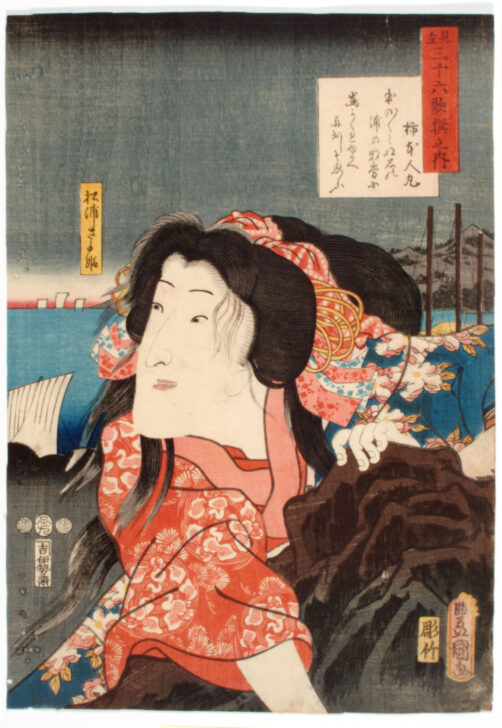Actors Compared with the Thirty-six Poet Immortals: Iwai Kumesaburō III as Matsuura Sayohime
Utagawa Kunisada

Description
In this series of prints, Toyokuni III (Kunisada) depicts popular kabuki actors against landscape backgrounds, and adds a cartouche with the name and a poem by one of the so-called "thirty-six poetic immortals," a selection of classical poets. The actors are identified only by the role and not by name, as actor prints had been forbidden in recent regulation. To a contemporary audience, of course, the actors would have been immediately recognizable by their physiognomies or actor's crests. Today, we can reconstruct the names of many, but not all, of the actors in the series.
In this print, an unidentified actor is shown as Matsuura Sayohime (Princess Sayo of Pine Bay). She seems to be clinging to a rock, with a three-masted ship behind her at right, and more distant sails on the horizon. The distant sails are what make the link to the great eighth-century poet, Kakinomoto Hitomaro. who was associated with a famous poem about sails disappearing from Akashi Bay.
The entire series is illustrated online at http://62.238.34.70/toshidama/prints.stm
Subject Matter:
This print juxtaposes Matsuura Sayohime with a poem by Hitomaro, an Asuka period (c. 6th-8th centuries) poet whose work appears in the classic poetry collections. Matsuura Sayohime did not appear in Kabuki plays until 1883. This print is likely a scene from the book Matsura Sayohime sekikonroku by Takizawa Bakin.
Utagawa Toyokuni III, the artist, was notable for creating images of actors in which specific individuals were identifiable. Not only were these popular actors recognizably depicted for fan consumption through these prints, but they were associated both with the poet immortals and specific flowers, each of which had special meanings in Edo society. Such layered meanings are hallmarks of mitate (literally meaning look and compare) prints. Mitate images were usually indicated by the use of the word mitate in the title, though it sometimes was omitted and viewers were meant to puzzle it out. This genre often juxtaposed contemporary figures such as kabuki actors with historical figures such as the poet immortals. Edoites enjoyed these layered meanings and would have made the connection between this series and the poet immortals with relative ease.
The actor, Iwai Kumesaburō III, was also known as Iwai Hanshirō VIII. He was born in 1829 and active from the time he was a child in the early 1830s. He became famous for his performances as an onnagata, a word which means "female role" or "female form." He died in 1882.
Physical Description:
In this picture, a woman smiles mischievously, facing her right. She is wearing two layers of robes, one red with white patterns, matching her hair tie, and one blue with pink and yellow flowers. One hand holds onto a large rock as she leans over it. Behind her a mountain and port are visible under a dark sky.
Inscriptions: Mitate sanjūrokkkasen no uchi; Matsura Sayohime; Toyokuni ga (Artist's signature); Horitake (Carver's seal); Kichi, Isekane (Publisher's seal); Hama & Magome, ne 9 (Censors' seal)
Usage Rights:
If you are interested in using an image for a publication, please visit https://umma.umich.edu/request-image/ for more information and to fill out the online Image Rights and Reproductions Request Form.